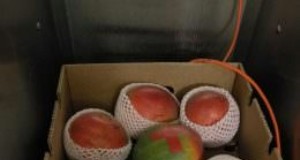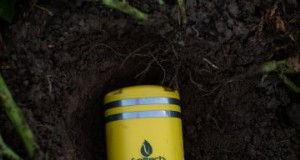INTRODUZIONE ALL'AGRICOLTURA DELLE SPEZIE:
Coltivazione delle spezie:la spezia è una sostanza che viene utilizzata negli alimenti a scopo di sapore, colore o conservazione. Spezie diverse si ottengono da parti diverse di una pianta o di un albero come semi, abbaia, radici e frutti. Alcune spezie dovrebbero avere proprietà antimicrobiche e antibatteriche. L'uso di alcune spezie si trova nei cosmetici, riti religiosi, medicinali e profumi. Si ritiene che diverse spezie abbiano avuto origine da diversi paesi del mondo. La cannella e il pepe nero sono originari dell'Asia meridionale e del Medio Oriente, chiodi di garofano durante la civiltà mesopotamica, noce moscata delle isole Banda nel sud-est asiatico. La domanda di spezie era più alta in Europa durante il Medioevo. Durante questo periodo le spezie venivano importate dall'Asia e dall'Africa. Nel periodo moderno c'era una forte domanda per il mercato del pepe in India. Il problema principale con le spezie in questi giorni è la diluizione. La qualità delle spezie è diventata inferiore a causa dell'adulterazione (mescolando altri prodotti indesiderati nella miscela originale).
Diverse forme di spezie sono fresche, essiccato e in polvere. Le spezie sono generalmente disponibili nella sua forma secca per una maggiore fruibilità e una maggiore durata. Ci sono alcune spezie che se usate fresche danno più essenza di quelle essiccate come lo zenzero. Le spezie come la curcuma vengono sempre utilizzate in polvere. Spezie come il finocchio e la senape vengono utilizzate sia intere che in polvere. Il sapore di una spezia si perde quando esposto all'aria a causa dell'ossidazione e dell'evaporazione. Così, si consiglia vivamente di conservare le spezie intere e di macinarle quando richiesto in modo da ottenere il massimo sapore. Le spezie utilizzate per la cottura vengono aggiunte presto durante la preparazione in modo che il sapore venga infuso nel cibo a differenza delle erbe che vengono aggiunte alla fine della preparazione.
 Pratiche di coltivazione delle spezie.
Pratiche di coltivazione delle spezie.
Le spezie dovrebbero contenere calorie, porzione di grasso, carboidrati, minerali, micronutrienti e proteine. Il cumino e lo zenzero mostrano un'elevata proprietà antiossidante che aiuta come conservanti naturali.
Le spezie sono contaminate da un batterio chiamato salmonella. Alcuni di questi batteri sono resistenti agli antibiotici e ora vengono trattati con il metodo di sterilizzazione con radiazioni.
COLTIVAZIONE DI SPEZIE DI CURCUMA:
 Curcuma.
Curcuma. - INTRODUZIONE: Il binomio della curcuma è Curcuma longa e appartiene alla famiglia dello zenzero. È considerato originario del subcontinente indiano. Questo è un rizoma che viene utilizzato sotto forma di polvere secca. Ha proprietà medicinali quindi viene utilizzato per trattamenti antibatterici. È di colore giallo e ha un buon profumo.
- CONDIZIONI DEL SUOLO E CLIMATICHE PER L'AGRICOLTURA DI SPEZIE DI CURCUMA: Per la coltivazione della curcuma vengono utilizzati terreni sabbiosi e argillosi, ricchi di humus e ben drenati. Viene coltivato a livello del mare o ad un dislivello di 1500 m sopra il livello del mare. Si stima che la temperatura della regione sia 20-30 gradi Celsius e la media le precipitazioni dovrebbero essere intorno ai 1500-2250 mm
- PROPAGAZIONE: La curcuma viene propagata attraverso talee di rizoma che vengono piantate durante la tarda stagione invernale.
- PREPARAZIONE DEL TERRENO E IMPIANTO: pozzi di 3 pollici di profondità sono realizzati utilizzando una zappa a mano e il la distanza tra le file è di 25 cm x 30 cm . Questi sono ricoperti di terra e letame bovino secco. Creste e solchi sono distanziati a distanza tra le file di 45-60 cm e distanziati di 25 cm per le piante.
- CONCIME E IRRIGAZIONE: Il letame bovino a 40 tonnellate/ha è ampiamente utilizzato per l'agricoltura della curcuma. Poiché questa pianta è di tipo irriguo, richiede 15-20 cicli per terreni pesanti e 35-40 cicli per terreni leggeri. FYM @10 tonnellate/ha è necessario per la medicazione di base. la razione di N:P:K è 125:37:37 kg/ha.
- La pacciamatura viene eseguita due volte con la spazzatura di canna da zucchero o verde foglie a 12-15 ton/ha a distanza di 50 giorni.
- GESTIONE DELLA MALATTIA: la trivellatrice è controllata da spruzzando 0,1% Malathion . La scala del rizoma è controllata immergendo i rizomi in chinalphos 0,1% prima della semina. La putrefazione del rizoma è controllata usando ditano M-45 0,3% durante la preparazione del terreno. La macchia fogliare è controllata da spruzzando 0,2% ditano M-45 .
- RACCOLTA E LAVORAZIONE: la raccolta avviene dopo 10 mesi dalla semina quando il rizoma diventa maturo. Il caldo fa bene alla curcuma, quindi se seminato ad ottobre si raccoglie ad agosto. I rizomi vengono bolliti fino a renderli morbidi ed essiccati al sole spalmati su stuoie di bambù per circa 15 giorni.
- PRODOTTO: In media un acro di terra produce 8-10 tonnellate di curcuma.
COLTIVAZIONE DI SPEZIE D'ALLORO:
 Foglia d'alloro.
Foglia d'alloro. - INTRODUZIONE: Foglia di alloro (Nome binomiale:Laurus nobilis). È nato nel Mediterraneo e raggiunge un'altezza di 40 piedi. Le piante hanno foglie verdi di media grandezza. È usato come agente aromatizzante e come medicinale.
- CONDIZIONI DEL SUOLO E CLIMATICHE PER L'ALLEVAMENTO DELLA SPEZIA: La luce del sole è una prerogativa e il vento freddo o il gelo possono essere dannosi. Il clima favorevole è il clima mediterraneo caldo e umido. Un terreno ben drenato con sufficiente materia organica è altamente adatto con a Gamma di pH di 6-8.
- PROPAGAZIONE: Germogli stratificati o talee di radice vengono utilizzati per la propagazione dell'alloro.
- PREPARAZIONE DEL TERRENO E IMPIANTO: Il terreno viene integrato con letame e le erbacce vengono rimosse con l'aratura.
- CONCIME E IRRIGAZIONE: Il letame marcio dell'aia è utile per aumentare la ricchezza del suolo. Un'adeguata fornitura di acqua è fornita attraverso l'irrigazione a goccia per mantenere intatta l'umidità del suolo.
- GESTIONE DELLA MALATTIA: acari, afidi e squame dure sono parassiti che infettano l'albero e sono controllati dall'applicazione di olio di neem. Lo spray allo zolfo previene macchie nere e danni alle foglie.
- RACCOLTA E LAVORAZIONE: Essendo una varietà sempreverde, le foglie sono disponibili tutto l'anno per la raccolta. Generalmente sono asciutti prima dell'uso.
- PRODOTTO: Un ettaro di terreno produce 6 tonnellate di foglie.
PRODUZIONE DI SPEZIE DI NOCE MOSCATA E MACIS:
- INTRODUZIONE: noce moscata e macis sono i prodotti dello stesso albero (nome botanico:Myristica fragrans houtt). Questo albero è originario dell'Indonesia e ora viene coltivato in alcune parti dell'India. È un albero sempreverde, densamente foliato, che raggiunge i 20 m di altezza. Queste spezie sono utilizzate negli aromi alimentari, profumi, preparazione di oli e burri.
- CONDIZIONI DEL SUOLO E CLIMATICHE PER L'AGRICOLTURA DI SPEZIE ALLA NOCE MOSCATA: caldo, clima umido con precipitazioni annue di 150 cm è richiesto per questi alberi. La zona ideale è dal livello del mare a 1300 m sopra il livello del mare. I pendii dei Ghati occidentali e orientali sono una buona scelta per l'agricoltura di noce moscata e macis. Terreno con argilla, terriccio, sabbia e laterite rossa sono adatte a questo albero.
- PROPAGAZIONE: Il seme dei frutti di questo albero viene utilizzato per la propagazione. Anche la stratificazione aerea e il germogliamento sono metodi efficaci per la propagazione, ma la tecnica di “innesto di epicotilo” è il più produttivo.
- PREPARAZIONE DEL TERRENO E IMPIANTO: quando le piantine crescono, dopo da 12 a 18 mesi vengono trapiantati nell'area principale. Le fosse cubiche di dimensioni 60 cm vengono scavate e riempite con terriccio e compost. La distanza tra le fosse è 8 m x 8 m . La semina viene effettuata durante la stagione delle piogge. L'ombra è necessaria durante i primi anni. La pacciamatura viene effettuata con i rifiuti disponibili nei dintorni.
- CONCIME E IRRIGAZIONE: L'albero richiede un'enorme quantità di letame per una maggiore resa e crescita. FYM @ 10 kg/pianta viene utilizzato per il primo anno. Un albero di 15 anni richiederebbe circa 50 kg di letame. Azoto @ 20 grammi, fosforo @ 18 grammi e potassio @ 50 grammi vengono applicati a ciascuna pianta nel primo anno. La dose aumenta con l'età dell'albero e viene applicata due volte all'anno; maggio-giugno e settembre-ottobre. L'irrigazione non è molto richiesta.
- GESTIONE DELLA MALATTIA: Il deperimento causato da diplodianatalensis è controllato applicando la poltiglia bordolese all'estremità dei rami. La luce del filo è causata da Marasmius sp. si controlla spruzzando l'1% di poltiglia bordolese. La putrefazione della frutta è causata da Phytophthora e Diplodia natalensis che è controllata dalla spruzzatura 1% di Bordeaux
- RACCOLTA E LAVORAZIONE: Se si utilizzano piantine il cuscinetto inizia in 7-8 anni, ma se l'innesto è fatto allora la produzione inizia in 4-5 anni. La piena portanza si raggiunge dopo 15-20 anni e rende fino a 60 anni. La raccolta si effettua da giugno ad agosto. La maturazione del frutto è nota quando la buccia carnosa si apre. Il macis viene separato dalla noce ed essiccato lentamente al sole per 10-15 giorni. Il seme viene anche essiccato separatamente per 4-8 settimane al sole o attraverso processi artificiali. Il guscio esterno viene rimosso e il dado viene estratto.
- PRODOTTO: La produzione media di un singolo albero è di 2000-3000 frutti all'anno. Si prevede che un ettaro di terra possa produrre 800 kg di noce moscata e 100 kg di macis.
COLTIVAZIONE DI SPEZIE ALL'ANICE STELLATO:
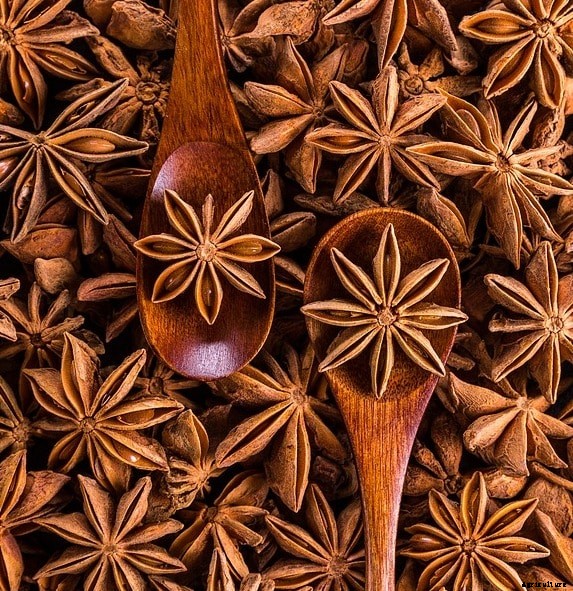 Anice stellato.
Anice stellato. - INTRODUZIONE: Questa spezia prende il nome dalla forma. Il suo nome botanico è Illicium verum. La Siberia è considerata ideale per la coltivazione dell'anice. Questa è una spezia di colore marrone scuro con un forte aroma. Questo è anche chiamato come anice e ha proprietà medicinali. È un albero sempreverde e raggiunge un'altezza di 5-10 m.
- CONDIZIONI DEL SUOLO E CLIMATICHE PER L'AGRICOLTURA DI SPEZIE ALL'ANICE STELLATO: Il terreno ricco di humus o leggermente acido è il più adatto per la coltivazione dell'anice. Richiede clima subtropicale dove la temperatura non è inferiore a -10 gradi Celsius. La pianta necessita di un clima caldo e soleggiato dove non ci siano venti secchi o freddi. Il pH del suolo è 6-6,7.
- PROPAGAZIONE: La propagazione avviene seminando direttamente semi o talee. La temperatura per la propagazione è di 18-20 gradi Celsius.
- PREPARAZIONE DEL TERRENO E IMPIANTO: Le piantine di 6 settimane vengono seminate con una spaziatura di 12 pollici . Ogni riga è separata di 18-24 pollici . La semina avviene in primavera.
- CONCIME E IRRIGAZIONE: È sufficiente mantenere un'umidità adeguata. In inverno è necessaria pochissima irrigazione. Spargere uno strato di compost da 3 pollici intorno all'albero è il miglior fertilizzante. A volte per una maggiore resa e qualità un sintetico Fertilizzante NPK o Bactofil B-10 e slavol (fertilizzanti biologici).
- GESTIONE DELLA MALATTIA: poiché è una varietà antibatterica e repellente dei parassiti, quindi non è necessario molto per gestire alcuna malattia per queste piante.
- RACCOLTA E LAVORAZIONE: L'albero richiede 6 anni per dare frutti quando cresciuto dai semi. I frutti vengono raccolti a maturazione ed essiccati al sole fino a che non virano il colore dal verde al bruno rossastro.
- PRODOTTO: In condizioni favorevoli la resa media dei frutti di questo albero è di 1551 kg/ha.
PI COLTIVAZIONE DI SPEZIE AL Cardamomo:
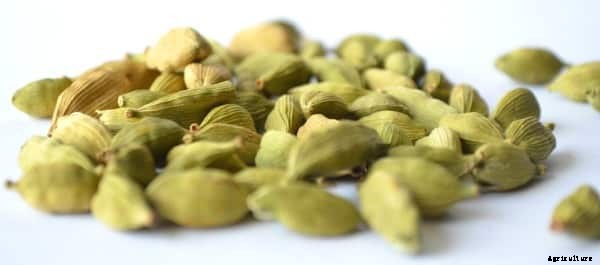 Cardamomo.
Cardamomo. - INTRODUZIONE: Questo è anche chiamato cardamomo nero e il suo nome binomiale è Amomum subulatum. I baccelli hanno un forte aroma affumicato e sono usati come spezie. Il prodotto più grande proviene dal Nepal. Ha anche usi medicinali come il trattamento dell'ittero.
- CONDIZIONI DEL SUOLO E CLIMATICHE: Questa spezia è coltivata ad altitudini di 1000-2000 sopra il livello medio del mare. Richiede una piovosità media annua di 3000-3500 mm . Profondo, un terreno argilloso ben drenato è buono per queste piante. Il pH del terreno deve essere mantenuto a 4.5-6.
- PROPAGAZIONE: La propagazione di questa pianta avviene per via vegetativa tramite rizomi o per seme. I rizomi delle piante coltivate vengono prelevati e trasformati in cespi più piccoli e piantati in fosse.
- PREPARAZIONE DEL TERRENO E IMPIANTO: Si considera pendenza moderata per la coltivazione di questa pianta. Pozzi di dimensioni 30 x 30 x 30 cm sono scavati con una spaziatura di 5 x 1,5 m tra ogni fossa durante il monsone. Le fosse sono ricoperte di terriccio e compost. Le piantine vengono messe a dimora al centro della fossa e la pacciamatura viene effettuata con foglie secche alla base della pianta.
- CONCIME E IRRIGAZIONE: Letame bovino e panelli non commestibili usati come letame. Una migliore irrigazione offre una resa maggiore. L'irrigazione a pioggia viene utilizzata a seconda delle necessità.
- GESTIONE DELLA MALATTIA: In questa pianta possono verificarsi malattie fungine e batteriche. Le due principali minacce a questa pianta sono Chirke e Foorkey.
- RACCOLTA E LAVORAZIONE: quando il seme di una capsula diventa marrone, le zappe vengono tagliate di 30-35 cm e lasciate maturare per 10-15 in più La raccolta viene effettuata da un'attrezzatura denominata ' Elaichichurri' e le punte sono ammucchiate. Le capsule vengono separate ed essiccate. Il calice viene rimosso strofinando la capsula su un filo.
- PRODOTTO: La stima mostra che un acro di terra genera 2000 kg di cardamomo secco.
MINORE COLTIVAZIONE DI SPEZIE AL CARDAMOMO:
- INTRODUZIONE: Questa spezia è originaria del subcontinente indiano ed è la spezia più necessaria dell'intero elenco. È una pianta sempreverde che si trova nei Ghati occidentali. Il nome binomiale di questa spezia è Elettaria Cardamomum L. L'altezza massima di questa pianta è di 2-4 metri e le varietà presenti in India sono Mysore, Tipo Malabar e vazhukka.
- CONDIZIONI DEL SUOLO E CLIMATICHE PER L'AGRICOLTURA DI SPEZIE DI CARDAMOMO: La temperatura e le precipitazioni ottimali richieste per la coltivazione di spezie di cardamomo inferiore è un 10-35 gradi Celsius e 1500-4000 mm rispettivamente le precipitazioni annuali. Il terreno argilloso nero con ricco humus, specialmente nella fascia forestale, è il più adatto per la coltivazione di questa spezia. Il terreno sabbioso non è affatto preferito.
- PROPAGAZIONE: I semi o i polloni sono usati per la propagazione. Questi semi vengono allevati in vivai e piantati nell'area principale in condizioni adeguate.
- PREPARAZIONE DEL TERRENO E IMPIANTO: Pozzi da 45 cm x 45 cm x 30 cm vengono scavati in aprile-maggio e vengono riempiti con compost e terriccio. La semina viene eseguita lungo i contorni di un pendio con spaziatura di 2 m x 1 m . L'inizio del monsone è l'ideale per piantare questi semi e vengono trapiantati in estate nell'area principale con una spaziatura di 20 cm x 20 cm . L'ombra è fornita e l'acqua viene fornita regolarmente.
- CONCIME E IRRIGAZIONE: Azoto @90 grammi, fosforo @60 grammi e potassio @ 120 grammi sono necessari per un letto di 5 m x 1 m. Questa dose viene fornita in tre rate con un intervallo di 45 giorni l'una dall'altra. Il contenuto di fertilizzante utilizzato per questa coltura è azoto @ 75 kg, fosforo @75 kg e potassa @150 kg per ettaro se viene irrigato da fonti esterne, ma se i campi sono irrigati dalla pioggia allora la razione di fertilizzante utilizzata è 30:60:30 kg/ha. Il fertilizzante totale viene applicato diviso e applicato due volte:uno a maggio e l'altro a settembre. 30 cm intorno alla pianta vengono applicati i fertilizzanti. L'irrigazione è molto richiesta durante la formazione delle pannocchie, fioritura e formazione dei frutti. Fino all'arrivo dell'irrigazione monsonica viene eseguita ad un intervallo di 10-15 giorni.
- GESTIONE DELLA MALATTIA: Tripidi e piralide sono controllati spruzzando monocrotophos 0,025% (marzo-settembre). Gli afidi sono controllati spruzzando lo 0,05% di dimetoato. I nematodi parassiti vengono controllati trattando le piante con carbofuran 3g @ 5kg a.i/ha. La putrefazione della capsula è controllata mediante spruzzatura 1% Bordeaux Il marciume del rizoma viene controllato trattando il terreno con 0,2% di ossicloruro di rame .
- RACCOLTA E LAVORAZIONE: Le piante iniziano a dare frutti subito dopo due anni dalla semina. La raccolta avviene nel periodo ottobre-novembre. I frutti raccolti vengono essiccati con un essiccatore elettrico ad una temperatura di 45-50 gradi per circa 14-18 ore .
- PRODOTTO: Si stima che un ettaro di terreno produca 1300 kg di cardamomo secco.
COLTIVAZIONE DI SPEZIE DI CORIANDOLO:
 Coriandolo.
Coriandolo. - INTRODUZIONE: Questa è un'erba originaria della regione mediterranea. In India alcuni stati coltivano il coriandolo, ma principalmente è per uso locale piuttosto che per l'esportazione. Molto poco viene esportato in altri paesi. Il nome binomiale di questa pianta è Coriandrum Sativum L. È molto desiderabile per il suo gusto e aroma. Sia le foglie della pianta che i frutti secchi vengono utilizzati nella preparazione del cibo. Queste piante erbacee raggiungono un'altezza di 30-70 cm. Ha anche alcuni usi medicinali.
- CONDIZIONI DEL SUOLO E CLIMATICHE PER L'AGRICOLTURA DEL CORIANDOLO: Questa pianta è adatta alla coltivazione tutto l'anno ed è una varietà tropicale. Ogni tipo di terreno ricco di sostanza organica è adatto alla sua coltivazione. Il terreno di cotone nero è considerato il migliore con precipitazioni sufficienti.
- PROPAGAZIONE: La propagazione avviene attraverso i semi.
- PREPARAZIONE DEL TERRENO E IMPIANTO: Dopo l'inizio del monsone il terreno viene arato 3-4 volte e poiché si tratta di una coltura Rabi la semina dei semi viene effettuata nei mesi di ottobre e novembre. Necessita di un ettaro di terreno 10-15 kg di semi. Una tecnica di germinazione migliore è immergere i semi in acqua per 12-24 ore prima della semina. Le file nella fattoria sono separate da una distanza di 30-40 cm e la profondità massima è di 3 cm.
- CONCIME E IRRIGAZIONE : Viene utilizzato FYM @ 10 tonnellate/ha. Fertilizzanti NPK @ 15 kg, 40kg e 20kg per ettaro rispettivamente, per le colture irrigue è richiesto, considerando che per le colture pluviali NPK @ 20 kg, 30 kg, 20kg per ettaro è richiesto rispettivamente. Sono necessari 4-6 cicli di irrigazione durante l'intera coltivazione. Ogni ciclo di irrigazione viene eseguito con un intervallo di 30-35 giorni.
- GESTIONE DELLA MALATTIA: Gli afidi sono controllati dal irrorazione dello 0,3% di Malathion mentre la lombrica viene controllata utilizzando il 4% di polvere di endosulfano @ 20-25 kg/ha. L'oidio e l'avvizzimento sono controllati spruzzando zolfo umido. La galla dello stelo è controllata usando lo 0,1% di bavistin e la peronospora è controllato usando lo 0,2% di mancozeb.
- RACCOLTA E LAVORAZIONE: Generalmente il raccolto viene raccolto entro 90-110 giorni . Il cambiamento del colore del frutto dal verde al marrone indica il momento della raccolta.
- PRODOTTO: La resa delle colture pluviali è di 400-500 kg/ha e quella delle colture irrigue è di 600-1200 kg/ha.
COLTIVAZIONE DI SPEZIE DI FENOGRINO:
 Fenugreek.
Fenugreek. - INTRODUZIONE: This herb is native to Eastern Europe and west Asia. The leaves and the seeds are used in food preparation. Its binomial name is Trigonella Foenum-graecum L. The maximum height of the crop is 0.9 m. There are two major varieties of crops grown T. Foenum-graecum (methi) and corniculata (kasuri methi).
- SOIL AND CLIMATE CONDITIONS FOR FENUGREEK SPICE FARMING: Both temperate and tropical climate are suitable for its cultivation. During seed germination temperature is being maintained around 8-27 degree Celsius. It can resist frost and extreme cold climate. Very low rainfall is required for this crop. Clayey loam is extremely good for these crops with a pH of 6-7
- PROPAGATION: Propagation is done by seeds. Seeds are soaked in warm water for 6-12 hours before sowing.
- LAND PREPARATION AND PLANTING: Ploughing is done thrice before sowing seeds and the soil beds are created uniformly with spacing between rows as 20-25 cm . In the plain area September to November is usually preferred for sowing the seeds, whereas in hilly areas the sowing is done in March.
- MANURING AND IRRIGATION: FYM @15 tonnes per hectare viene utilizzato. NPK fertilizers @25 kg, 25 kg, 50 kg/ha respectively is required. Nitrogen is applied in two installments whereas the other two types of fertilizers are applied to the base of the crops at a time. 4-6 irrigation cycles are required during entire crop growth with an interval of 20-25 days between each cycle. Pre-irrigation is also done.
- DISEASE MANAGEMENT: root rot is caused by Rhizoctoni Solani and is controlled by drenching the soil with carbendazim 0.05%. Powdery mildew is controlled by spraying dinocap @20-25 grams/10 liters of water . Downy mildew is controlled by spraying 0.2% of difoltan solution.
- HARVESTING AND PROCESSING: Young shoots are removed within 25-30 days of sowing. The leaves are cut within 15 days of growth and minimum 2 cuttings are done before the flowering and fruit formation of the crop. The crops are removed when the pods dry and the entire thing is dried in the sun, which facilitates the removal of seeds by rubbing with the hands. Again the removed seeds are dried in the sun and packed.
- YIELD: One hectare of land produces 1200-1500 kg of seeds and 800-1000 kg of leaves.
ROSEMARY SPICE FARMING:
 Rosemary.
Rosemary. - INTRODUZIONE: Rosemary is a perennial herb and is evergreen in nature. It is a native of the Mediterranean region and its binomial name is Rosmarinus officinalis. The shrub has a maximum height of 1.5m. This crop is famous for its aroma; the leaves, twigs and flowers are used for various purposes.
- SOIL AND CLIMATE CONDITIONS FOR ROSEMARY SPICE FARMING: Well-drained lateritic soil is best for the cultivation of rosemary crops. The pH of the soil is maintained in-between 5.5-7. 20-30 degree Celsius is the ideal temperature for its growth. Average annual rainfall of 10-20 cm is required a nd an altitude of 2500 m above sea level is considered good for growing rosemary.
- PROPAGATION: Seeds are used for growing rosemary plants, but with extreme care and typical conditions. Also cuttings, roots and layering are sometimes used to grow rosemary.
- LAND PREPARATION AND PLANTING: Land to be used for cultivation is ploughed two times and neem care is mixed as a source of manure. The spacing between rows of rosemary plants have to be 40-50 cm and beds of width 1-2 m is created. Initially the cuttings are raised in the nursery and then shifted to main area during midsummer.
- MANURING AND IRRIGATION: FYM @ 50 tonnes/ha, neem cake@1 ton/ha, natural compost@ 5 tonnes/ha and vermicompost @5 tonnes /ha as applied at the base of the crop during initial planting. Subsequent year onwards 5-30 kg per hectare viene applicata.
- DISEASE MANAGEMENT: This shrub is resistant to pests and fungus.
- HARVESTING AND PROCESSING: When the flowering starts the plants can be harvested. From second year harvesting is done every four months. The leaves are cleaned thoroughly and dried in shade for 10-15 days .
- YIELD: one hectare of land annually produces 2.5 tonnes of dried leaves of rosemary.
CHILLIE SPICE FARMING:
 Chilli spice.
Chilli spice. - INTRODUZIONE: very common and needed Indian spice is chilli. It originated from Mexico, but the largest producer of chillies Japan. It is both a spice and a vegetable variety. The binomial name of the chili is capsicum annuum. It is a shrub
- SOIL AND CLIMATE CONDITIONS FOR CHILLIE SPICE FARMING: It needs warm, humid and dry weather. Temperature ranges from 20-25 degree Celsius . Temperatures beyond 35 degree effect the fruit development. Very little moisture is required to grow chillies. Well-drained sandy loam soil having high organic content is useful for growing chillies. The pH of the soil should be in-between 5-7.5. 2100 meters above mean sea level is the altitude up to which chillies can be grown.
- PROPAGATION: chilli propagates through seeds.
- LAND PREPARATION AND PLANTING: 2-3 ploughings are given to the soil before sowing seeds. Before sowing the soil is sterilized to make it free from fungus and other infections. Seeds are initially planted in nurseries and then transplanted to the main area. Coco peat is used to cover the soil with seeds and is lightly watered until seedling stage. The crop distance is 45 cm x 45 cm in the main area. Ridges and furrows of dimensions 60 x 45 cm is maintained for intercropping. Each raised bed of chilli is dimensioned as 30 x 120 cm .
- MANURING AND IRRIGATION: These plants do not require much water. Irrigation is done only when the moisture content of water drops to less than 25%. 1 kg of azospirillum with 50 g of FYM is used as manure.
- DISEASE MANAGEMENT: White ants are treated using 8-10 aldrin/acre. Fruit rot, die back, appassire, muffa polverosa, leaf spot is treated with 1% Bordeaux mixture. Neem cake @100 kg is used to destroy grubs.
- HARVESTING AND PROCESSING: Harvesting is done at regular intervals. They are dried in shade for 2-3 days.
- YIELD: One acre of land produces 30-40 quintals of fresh chillies and of which 25-35 kg of dried chillies is obtained from every 100 kg of fresh chillies.
 Red Chilli.
Red Chilli.
CELERY SPICE FARMING:
- INTRODUZIONE: The binomial name of celery is apium graveolens. It is an herb used for various purposes. The height of the herb is 10-14 inches and has white colored flowers. It is a native of the Mediterranean region.
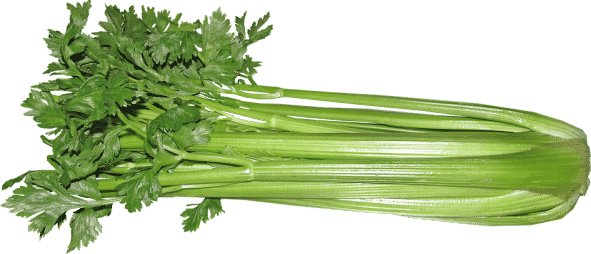 Celery.
Celery. - SOIL AND CLIMATE CONDITIONS FOR CELERY SPICE FARMING: During the growing stage it needs cold climate and during maturing it needs warm climate. A well drained loamy soil is considered good for this herb. The min temperature requirements are 12-30 degree Celsius with an average rainfall of 100 cm. The pH of the soil is maintained at 5.6 for good produce.
- PROPAGATION: propagation is done using seeds which are initially raised in a nursery and then transplanted to the main area.
- LAND PREPARATION AND PLANTING: Land is ploughed four to five times before planting. The spacing of these celery plants is 45 cm x 25 cm and the sowing depth is 2-4 cm. The seeds take 4-8 weeks for seedling and after 2 months, transplanted to the main area. November is the best time for sowing seeds.
- MANURING AND IRRIGATION: FYM @ 20-25 tonnes are used insieme a nitrogen @200 kg, phosphorous @100 kg and potash @150 kg per hectare is required. Irrigation is highly essential and is given at an interval of 10-15 days.
- DISEASE MANAGEMENT: Damping –off, Fusarium yellows, early blight downy mildew is controlled by drenching the land with 400 grams of copper Oxy chloride .
- HARVESTING AND PROCESSING: 4-5 months after sowing, the crops are harvested.
- YIELD: one hectare of land yields about 25-30 tonnes of celery.
CUMIN SPICE FARMING:
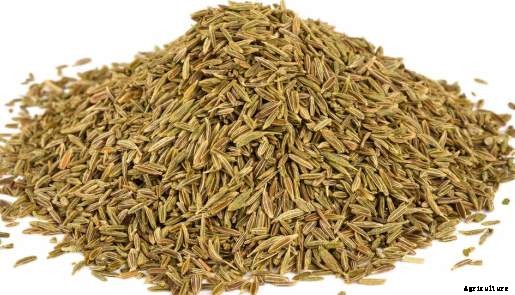 Cumin Seeds.
Cumin Seeds. - INTRODUZIONE: This is a flowering plant and native to the Middle East and India. Its binomial name is Cuminium Cyminum. Cumin is a herbaceous plant whose seeds is dried and used as spice. The height of this plant is 30-50cm. In Hindi it is addressed as jeera which is most famous and widely used spice in Indian cuisines.
- SOIL AND CLIMATE CONDITIONS FOR CUMIN SPICE FARMING: Sandy loam soil with high nutrient content is required for the cultivation of cumin. The soil should be well drained and should be able to hold moisture. Mild climate is required for its cultivation and winter weather is also suitable. Sunlight is highly essential for its growth.
- PROPAGATION: seeds are used for propagation.
- LAND PREPARATION AND PLANTING: sowing of cumin seeds is done in December and the rows are spaced 30 cm apart.
- MANURING AND IRRIGATION: FYM @ 12-15 tonnes/ha insieme a phosphorus @20 kg, nitrogen @30 kg is applied to the soil. These fertilizers are applied in two splits. Initially the seedlings are lightly watered and the second irrigation is done after 7-10 days.
- DISEASE MANAGEMENT: Powdery mildew is controlled by spraying 20-25 grams /10 liters of water. Allo stesso modo, Alternaria blight is controlled by spraying 0.2% of dinocap.
- HARVESTING AND PROCESSING: Complete maturity in plants is obtained within 100-115 days from sowing. Harvesting is done by uprooting the entire plant and drying it. The dried plants are thrashed to remove seeds.
- YIELD: An average yield is 5 quintals per hectare.
GINGER SPICE FARMING:
 Ginger root.
Ginger root. - INTRODUZIONE: This spice is native to Asia and has high demand locally and internationally. It is an herb which grows to a height of 1 m and bears yellow flowers. This spice has many medicinal properties and refreshing aroma.
- SOIL AND CLIMATE CONDITIONS FOR GINGER SPICE FARMING: Caldo, humid climate is favorable for the growth of ginger. An altitude of 1400-1500 m is suitable for cultivation. This herb is grown in different soils. The pH of the soil should be 5-6.5.
- PROPAGATION: Propagation is done using rhizomes. The length of the rhizome should be 5-5 cm and should weight 20-25 grams .
- LAND PREPARATION AND PLANTING: 3-4 ploughings of land are done during summer. Crosswise harrowing is done to make the soil loose. A bed for the crops is made 1 m wide, 15 cm high . Each bed is separated by 50 cm. solarisation is done using polyethylene sheets for 40-45 days.
- MANURING AND IRRIGATION: FYM @ 15 tonnes/ha along with NPK @60 kg, 50 kg, 50 kg / ha respectively is used for growing these crops. Irrigation is provided at an interval of 8-10 days. Maximum 20 irrigation cycles are needed for the entire growing period. Drip irrigation is also preferred.
- DISEASE MANAGEMENT: Shoot borer is controlled by spraying 0.1% of Malathion. Rhizome flies are controlled by spraying 05% methyl parathion . Leaf roller and scales are controlled by spraying 0.05% dimethoate . Soft rot is controlled by captafol 0.1%. Leaf spot is controlled by a 1 % Bordeaux mixture . Root knot nematode is controlled by solarising. Bacterial wilt is controlled by spraying 200 ppm streptocycline .
- HARVESTING AND PROCESSING: Green ginger can be harvested in 215-220 days after planting the rhizomes. Yellowing of leaves indicates the harvesting season.
- YIELD: One hectare of land produces 10-15 tonnes of green ginger.
THYME SPICE FARMING:
 Thyme herb.
Thyme herb. - INTRODUZIONE: This is an evergreen herb with aroma, generally used for cooking and medicinal purposes. It originated from the Europe and spread throughout the world through Romans.
- SOIL AND CLIMATE CONDITIONS FOR THYME SPICE FARMING: Requires well drained, fertile soil. Warm climate is suited for thyme plants and hill regions are considered best for cultivation.
- PROPAGATION: It is propagated through seeds and also vegetatively by plants.
- LAND PREPARATION AND PLANTING: ploughing is highly essential to prepare the land and plants are planted 15-30 cm apart. The spacing between the rows is 60 cm.
- MANURING AND IRRIGATION: FYM @ 50 tonnes/ha, vermicompost @ 5 tonnes/ha, neem cake @1.25 kg/ha, azospirillum and phosphobacterium and panchagavya is sprayed @3%.
- DISEASE MANAGEMENT: No major diseases occur to this plant.
- HARVESTING AND PROCESSING: For cooking purposes leaves and flowers are used. Harvesting starts from 4-5 months of sowing. The shoots are cut from the plant with a length of 15 cm. When the leaves dry, they curl and turn brown.
- YIELD: one hectare of land yield 1100-2200 kg of thyme.
CLOVE SPICE FARMING:
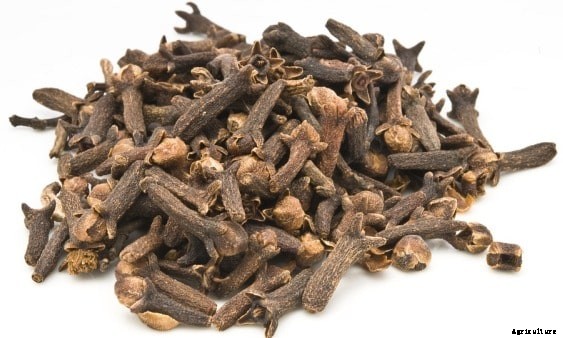 Cloves.
Cloves. - INTRODUZIONE: Clove is an evergreen tree with high medicinal properties. The binomial name is Eugenia caryophyllus and is native to the Indonesian island. This plant grows to a height of 7-15 m. The dry unopened flower bud of the plant is the clove. In India the Western Ghats are popular for clove cultivation.
- SOIL AND CLIMATE CONDITIONS FOR CLOVE SPICE FARMING: This plant requires a warm, humid climate of temperature 20-30 degree Celsius and an average rainfall of 150-250 cm . The altitude is generally estimated to be 1500 m above mean sea level. Black loamy soil with rich humus is well suited for clove cultivation. Sometimes it is also grown in clay loam and laterite soil.
- PROPAGATION: Seeds are used for the propagation of clove usually during June to October. The seeds are soaked in water before sowing.
- LAND PREPARATION AND PLANTING: Pits of dimensions 60 cm x 75 cm x 3 cm are dug with a spacing of 6-7 m and filled with topsoil. Planting of seeds is done at the end of the monsoon.
- MANURING AND IRRIGATION: Rotten cattle manure @15 kg is required initially, but as the plants grow, they need more manure. The manure is applied basally at a radius of 5 m dall'albero. Pot watering is required if there is no sufficient water supply. Plants need subsoil irrigation during peak summer season.
- DISEASE MANAGEMENT:
- HARVESTING AND PROCESSING: yielding starts during 7 years, but to attain full bearing the tree takes 15-20 years . After flowering the buds take 4-6 months for harvesting. The buds are dried for 4-5 days.
- YIELD: One fully grown tree gives 4-8 kg of dried buds.
FENNEL SPICE FARMING:
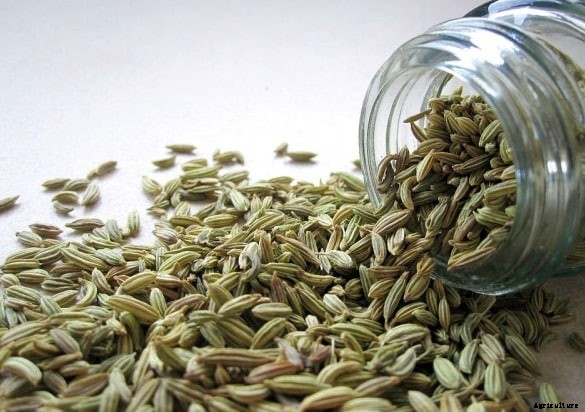 Fennel.
Fennel. - INTRODUZIONE: It is a flowering plant and native to the Mediterranean. This spice has an exclusive aroma and a different flavor. This herbaceous plant grows to a height of 2.5 m. The binomial name is Foeniculum Vulgare. In India it is addressed as Saunf in Hindi.
- SOIL AND CLIMATE CONDITIONS: Every kind of soil is suitable for the cultivation of fennel. But well drained sandy or loamy soil is best suited with a pH of 6.5-8. The optimum temperature for the cultivation of these crops is 15-25 degree Celsius with an average rainfall of 50-75mm .
- PROPAGATION: It is not a transplanting variety. Propagation is done through seeds directly sowed in the main area.
- LAND PREPARATION AND PLANTING: The land is ploughed two three times to prepare a fine seed bed. This plant is rarely raised in nurseries. Sowing is done during October and if it is a rain fed region, then spacing of 45 cm between rows with 10 cm crop spacing is maintained.
- MANURING AND IRRIGATION: Cow dung@4-6qtl/acre along with urea@45 kg/acre i s applied three times in equally split proportions. Pre-sowing irrigation is done and then at an interval of 10-15 days 10-12 cycles of irrigation is required during the entire duration of cropping.
- DISEASE MANAGEMENT: Aphids are controlled by spraying 0.03% of dimethoate . Seed midge and heliothis is controlled by spraying 0.07% of endosulphan .
- HARVESTING AND PROCESSING: Maturity of plants is known when seeds are full and green in color. The umbels are cut and dried in the sun for 2 days and then dried in the shade for 10 days. The crop harvesting is done in May i.e. after 180 days from sowing.
- YIELD:O ne hectare of land yields 10-11 quintals of fennel on an average.
BLACK PEPPER SPICE FARMING:
 Black Pepper.
Black Pepper. - INTRODUZIONE: The binomial name of black pepper is ‘piper nigrum’ and it is an evergreen flowering vine. This plant in mostly found in south India and grows to a height of 10 m. This is the earliest form of spice in India. There are 75 cultivars of pepper in India of which Karimunda is most popular. Other varieties are kottanadan, narayakkodi, aimpiriyan, kuthiravally, balancotta, kalluvally, malligesara and uddagare.
- SOIL AND CLIMATE CONDITIONS FOR BLACK PEPPER SPICE FARMING: pepper plants require tropical humid climate with sufficient rainfall (125-200 cm). The submountaeous region of Western Ghats is exclusive for growth of pepper plants. Clay loam, red loam and lateritic soils are suitable for pepper farming. The pH value of the soil is maintained at 4.5-6.0. The temperature should be in between 10-40 degree Celsius.
- PROPAGATION: Cutting from runner shoots is used for propagation of pepper. One third of the root is cut and planted in the nursery. They are obtained in the month of February –March. Roots develop from the cuttings and they are set for planting.
- LAND PREPARATION AND PLANTING: level land with proper drainage is chosen for farming. South facing slopes are avoided, but north or north eastern slopes are preferred to avoid the effect of the sun. Planting is done in the monsoon. Square pits of dimensions 0.5 m x 0.5 m are dug and the spacing between the pits is 2.5 m x 2.5 m . Seedlings which are two years old are planted in the pits. When the vine grows, it is initially made to creep on a pole of 2 m height. After a certain length the temporary stake is removed and planted in a trench of depth and width equal to 15 cm close to the tree trunk.
- MANURING AND IRRIGATION: Rotten cattle manure@ 10 kg is used as manure for pepper plants. 100 grams of nitrogen, 40 grams of P2O5 and 140 grams of K2O is used as a fertilizer for three year old plants. 1/3
rd
of the above mentioned composition is applied in the first year and 2/3rd of the quantity is applied in the second year. Lime @500 grams is applied as fertilizer during later stages of development.
- HARVESTING AND PROCESSING: Yield starts after 3 or 4 years from planting. The ripening takes 6-8 months from flowering and harvesting is done during November till February. The entire spike is plucked when the berries turn bright red. The spike is rubbed with hands to remove the berries which are then dried in the sun for 7 to 10 days until the berries turn black.
- YIELD: 800-1000 kg of black pepper is obtained from one hectare of plantation land (7-8 yrs old). The yield reduces after every 20-25 years.
CINNAMON SPICE FARMING:
 Cinnamon spice.
Cinnamon spice. - INTRODUZIONE: Cinnamon is the inner bark of the tree and is the first known spice with rich flavour. It is native to Sri Lanka. Also lower slopes of Western Ghats (Kerala and Tamilnadu) cinnamon cultivation are predominant. Binomial name is Cinnamomum Cassia.
- SOIL AND CLIMATE CONDITIONS FOR CINNAMON SPICE FARMING: lateritic and sandy soil is preferred for cinnamon plant. The elevation of land above sea level is approximately 1000 m . This plant requires an annual rainfall of 200-250 cm .
- PROPAGATION :Cinnamon is propagated by rooted cuttings, air layering and seeds. 10 cm long with 2 leaves semi hardwood cuttings are dipped in keradix-B and planted in a polythene bag consisting of sand and coir dust mixture in the ratio 1:1. These are watered twice in a day and stored in the shade. Dopo 45-60 days the roots develop indicating that it can be transplanted to a another permanent place
- A ring from the semi hardwood bark is removed and IBA 2000 ppm viene applicato su di esso. This region is covered with coir husk and wrapped with 20 cm of polythene. Rooting starts after 40-60 days and the air layers are detached from the parent plant. These can be planted in the main area during monsoon
- For the sowing of seeds a mixture of sand, soil and rotten cattle manure in the ratio 3:3:1 is prepared and germination starts after 15 -20 days. Moisture is a must for these plants.
- LAND PREPARATION AND PLANTING: Pits of dimensions 50 cm x 50 cm x 50 cm are dug with space between each pit being 3m x 3m. The pit is initially filled with topsoil and compost and the seedling are planted. One acre land can accommodate 3600 pits
- MANURING AND IRRIGATION: 20 grams of nitrogen, 18 grams of P2O5 and 25 grams of K2O are used as fertilizer in the initial growth period. The dose increases with the age of the plants. Fertilizers are applied during may-June and September-October. Green leaves are used for mulching FYM @25 kg i s applied in May-June. Irrigation is essential during summer.
- DISEASE MANAGEMENT: Colletotrichum Gloeosporioides causes leaf spotting and die back disease. Diplodia sp. causes seedling blight. Pestalotia palmarum causes grey blight. All these are controlled by a 1 % Bordeaux mixture . Pests like leaf minor and cinnamon butterfly are controlled by the use of quinalphos (0.05%).
- HARVESTING AND PROCESSING: When the tree is grown to a height of 10-15 m in 4 years, shoots are available for peeling. Coppicing is done to encourage regrowth. Shoots of thickness 5-2 cm are chosen for the extraction of barks. 1-1.25 m of shoots are cut into straight pieces followed by scraping and peeling. The peels are dried in the shade and then in sunlight for 4 days. Dried barks take the shape of a quill. Grading of quills is done from 00000, 0 being the most coarse quality. Small bark pieces are called quillings; thin inner pieces are called featherings.
- Distillation of dried cinnamon leaves and barks produces oils. This oil is used in soaps, perfumes, creme, toothpastes etc.
- CULTIVARS AND YIELD: Two varieties are known in India, the Navashree and the Nithyashree. 56 and 54 kg of dry quills /ha /yr are obtained from Navashree and Nithyashree respectively. The product yield of Navashree is such that 2.7% bark oil, 73% cinnamaldehyde 8% oleoresin 2.8% leaf oil, 62% leaf eugenol. The product yield of Nithyashree is (2.7% bark oil, 58% cinnamaldehyde, 10% oleoresin, 3% leaf oil and 78% eugenol.
Read about Zero Budget Natural Farming.
Read about Hydroponic Growing System.






















